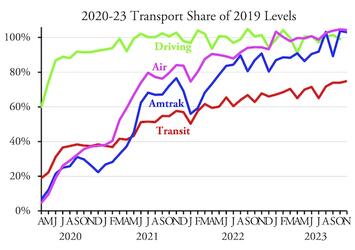
America’s transit systems carried nearly 75 percent as many riders in November 2023 as the same month in 2019, according to data released on Friday by the Federal Transit Administration. This is the most riders transit has attracted, as a share of pre-pandemic levels, since the pandemic began in March 2020.
Transit’s failure to carry even three-fourths of its pre-pandemic passengers stands in contrast to Amtrak, which carried 3.1 percent more passenger-miles in November 2023 than 2019, and the airlines, which carried 4.3 percent more riders in November than in 2019. Release of airline passenger-mile data tends to be more than a month later than passenger numbers, but in September domestic air routes carried 6.0 percent more passenger-miles than the same month in 2019. November highway data are not yet available but an update will be posted here when they are.
November’s ridership reached post-pandemic record levels partly because November had one more business day in 2023 than in 2019. Transit numbers were just under 74 percent in September and October and I suspect will be under 74 percent again in December, which had one fewer business day in 2023 than in 2019.
Conventional buses did better than average at 80 percent but commuter buses were much worse than average at 51 percent. Commuter rail was also poor at 66 percent while light and heavy rail both came in around 70 percent.
Total transit ridership was helped by the New York urban area, where more than 45 percent of all U.S. transit ridership takes place. New York saw nearly 78 percent as many riders in November as in the same month of 2019. Doing even better were Los Angeles (82%), Dallas (86%), Houston (85%), and San Diego (93%).
A big surprise is Cincinnati, where transit carried 102 percent of 2019 riders, and it apparently did so without cutting fares to zero as Kansas City (97%) and a few other regions have done. Another surprise is Washington DC, which managed to reach 77 percent despite having record high downtown office vacancies.
Major urban areas where transit is still doing poorly include Atlanta (58%), Detroit (57%), Phoenix (59%), and St. Louis (57%). Slightly better are Philadelphia (65%), Boston (66%), San Francisco-Oakland (62%), Minneapolis-St. Paul (64%), Denver (63%), Baltimore (68%), and Portland (66%).
Will transit ridership ever exceed 75 percent of pre-pandemic levels without the benefit of a month with one more business day than in 2019? Probably, but keep in mind that all other modes of travel have fully recovered to pre-pandemic numbers and are now growing at roughly pre-pandemic rates.
As of October, most downtowns still have a long way to go before they are recovered from the pandemic. Until they do, transit won’t fully recover either. I suspect transit ridership has leveled off at around 75 percent of pre-pandemic numbers and any growth beyond that will depend on ordinary population and economic growth — but maybe I think so only because that is what I predicted in 2020 when I wrote, “it seems likely that transit will lose at least 25% of its total riders” due the changes brought about by the pandemic.
Read the rest of this piece at The Antiplanner.
Randal O'Toole, the Antiplanner, is a policy analyst with nearly 50 years of experience reviewing transportation and land-use plans and the author of The Best-Laid Plans: How Government Planning Harms Your Quality of Life, Your Pocketbook, and Your Future.
Chart: Comparison of four transportation modes for 2020 - 2023.













MSP
But I read in the urbanist media that Minneapolis-St Paul is making wondrous progress.